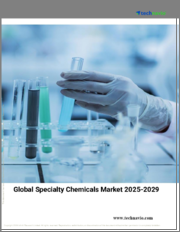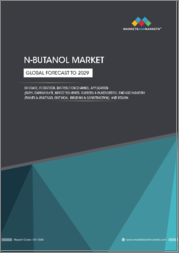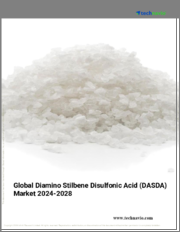
|
시장보고서
상품코드
1557365
세계의 특수 수처리 약품 시장 : 예측(2024-2029년)Specialty Water Treatment Chemicals Market - Forecasts from 2024 to 2029 |
||||||
특수 수처리 약품 시장의 2024년 시장 규모는 525억 6,700만 달러로 추정되고, 예측기간의 CAGR은 7.94%를 나타낼 것으로 예측됩니다.
특수 수처리 약품 시장의 주요 촉진요인은 화학 제조, 광업, 석유 및 가스와 같은 다양한 최종 사용자 산업의 소비 증가입니다. 또한 수질 오염 증가와 폐수 처리에 대한 엄격한 규제도 주요 촉진요인입니다. 지속가능한 화학치료의 이용 확대가 큰 동향이 되고, 생산 라이프사이클에서 유해성이 낮은 화학물질의 사용과 함께, 그 이용이 선호될 것입니다.
제품과 기술의 혁신이 진행됨에 따라 시장 확대로 이어질 것입니다. 아시아태평양은 중국, 인도, 일본 등의 국가에서 소비가 증가함에 따라 특수 수처리 약품의 중요한 시장이 될 것입니다.
특수 수처리 약품의 촉진요인
- 세계의 도시화의 진전
UNCTAD(유엔무역개발회의)에 따르면 도시 인구는 최근 동향에서 현저하게 증가하고 있으며 앞으로도 상당한 증가가 예상됩니다. 2022년 도시 인구는 45억 4,000만 명으로, 2050년에는 66억 500만 명에 이를 것으로 예상됩니다. 총 인구에서 차지하는 비율은 2022년 56.9%에서 2050년 68.0%로 증가합니다.
도시화가 특히 진행되고 있는 것은 아프리카와 아시아입니다. 이 지역에서는 인구 증가도 현저합니다. 급속한 도시화는 지속가능성에 과제와 기회를 제공합니다. 도시 생활은 많은 인구에 수처리 솔루션을 제공함으로써 자원을 활용하고 지속 가능한 개발을 창출할 수 있습니다. 이렇게하면 기본적인 생활 시설이 갖추어집니다. 특수 수처리 약품은 도시의 깨끗한 물에 대한 수요가 증가함에 따라 크게 성장하고 있으며, 개발 도상 산업은 규제 불만으로 인해 수처리가 필요합니다.
- 수질 오염 증가
수질 오염 증가는 세계의 많은 사회에 큰 우려입니다. 유엔에 따르면 2022년에는 22억 명이 관리하는 식수 서비스를 이용할 수 없으며 35억 명이 안전하게 관리된 위생 시설을 이용할 수 없습니다고 합니다. 이 수치는 더 나은 물 관리 시스템과 폐수 처리의 중요성을 보여줍니다.
이러한 우려는 특히 인구가 증가함에 따라 적절한 생활 환경에 대한 요구가 커지고 있는 개발 도상국에서 높아지고 있습니다. 또한, 농법에서 과도한 농약의 사용으로 인한 물 인구는 건강과 환경에 대한 우려를 유발합니다. 물 관리를 위한 수처리 플랜트의 치료는 깨끗한 물에 대한 수요를 충족시키기 위해 성장할 것으로 보입니다.
- 복수 산업에서의 수요 증가
일부 산업 수요 증가는 특수 수처리 약품이 성장하는 주요 요인입니다. 석유 및 가스 등의 산업에서는 방류전에 수중의 유분을 줄이는 화학약품이 필요합니다. 다우의 DEMTROL은 유중수 수준을 낮추고 분리를 용이하게 하고 더 많은 물을 효과적으로 제거하는 탈유화제 베이스 역할을 합니다. 이것은 생산 목표를 달성하는 데 도움이 됩니다. 이러한 방식으로 배출 또는 재주입을 위한 보다 깨끗한 생산수를 얻을 수 있습니다.
중금속은 사람과 환경에 해롭고 많은 산업 및 산업 분야에서 사용됩니다. 중금속은 불용성 수산화물로 침전되므로 제거할 수 있습니다. Evonic은 환경 규제를 위해 TMT 15를 제공합니다. TMT 15는 중금속과 반응하여 분리가 용이한 매우 안정적이고 실질적으로 불용성인 금속-TMT 고체 화합물을 형성합니다. 세계 주요 지역에서 산업화가 진행됨에 따라 규제에 대한 불만과 필요한 공정에 특수 수처리 약품의 응용이 기대되고 있습니다.
특수 수처리 약품 시장의 지리적 전망
- 예측 기간 동안 아시아태평양은 특수 수처리 약품 시장을 독점합니다.
지역별로는 북미, 남미, 유럽, 중동, 아프리카, 아시아태평양으로 구분됩니다. 아시아태평양은 중국, 일본, 인도, 한국 등 주요 경제국이 지배적입니다. 급성장하고 있는 신흥국 중에는 ASEAN 국가 등 이 지역의 국가도 있습니다.
세계은행에 따르면 2022-23년도 인도의 실질 GDP는 추정 6.9% 확대했습니다. 산업(건설 포함)의 부가가치는 높고 i. 이 기간 동안 GDP에서 차지하는 비율은 25%입니다. 성장 요인으로는 견조한 내수, 정부 인프라 투자 추진에 힘입은 강력한 투자 활동, 민간 소비 등이 있습니다.
국가 통계국(NBS)에 따르면 중국의 6월 부가가치 공업생산액은 전년 동월 대비 5.3% 증가하여 아시아 최대 경제대국의 견조한 성장률을 보였습니다. 이 지표는 산업용 특수 수처리 약품에 대한 수요를 시사합니다.
보고서 정보
이 조사 보고서는 특수 수처리 화학 시장을 유형, 최종 사용자, 지역 등 다양한 부문을 기반으로 조사했습니다. 첫째, 간단한 시장 개요는 주요 촉진요인 및 과제를 자세히 설명합니다. 그런 다음 Porter's Five Forces 모델에서 특수 수처리 약품 산업을 종합적으로 분석합니다. 이어 업계의 밸류체인 분석이 수행되어 어떤 기업이 다양한 프로세스에 속하며 다양한 분야에 기여하는지 밝혀집니다.
또한 특수 수처리 약품 시장에 영향을 미치는 시장 개척, 동향, 업계 정책 및 정책에 대한 자세한 정보를 제시합니다. 또한 본 조사에서는 특수 수처리 약품분야의 전반적인 규제 프레임워크를 분석하여 시장환경 전체에 영향을 미치는 주요 요인에 대해 이해관계자에게 이해를 깊게 해 주도록 하고 있습니다.
특수 수처리 약품의 주요 발전 :
- 2024년 6월 : 인도에 수처리 약품 판매의 현지법인 Kurita AquaChemie India(KAIL)를 설립했습니다. 타밀 나두 주 첸나이시에 설립했습니다. 인도는 세계 최고의 경제적 중요성을 지닌 지역입니다. 경제 성장에 따라 수처리 요구는 다양한 산업에서 증가하고 있습니다.
- 2024년 1월 : Italmatch Chemicals 그룹은 바이오에탄올, 설탕 제조 및 산업용 수처리를 전문으로 하는 브라질 대기업 알코리나의 과반수를 인수하는 구속력 있는 계약을 체결했습니다.
- 2023년 11월 : 물 집약 산업을 위한 지속가능한 화학 솔루션의 세계 리더인 Chemila는 영국 구울에 황산 제2철 수처리 약품 생산 라인을 설치할 것이라고 발표했습니다. 70,000톤의 생산 능력 추가 투자는 보다 엄격한 규제에 대응하는 데 도움이 됩니다.
- 2022년 6월 : Italmatch Chemicals는 영국과 아일랜드의 주식 투자자 BGF로부터 오빈 그룹을 인수했습니다. 석유 및 가스산업과 신재생 에너지 분야를 위한 혁신적인 화학 솔루션의 중요한 전략적 개발 및 공급기업으로 영국과 중동에서 사업을 전개하고 있습니다. Italmatch Chemicals는 물, 석유 및 가스, 산업용 윤활유 및 플라스틱 치료와 관련된 화학제품을 제조 및 판매하는 세계의 특수 화학 그룹입니다.
특수 수처리 약품 시장은 다음과 같이 세분화되고 분석됩니다.
유형별
- 부식 억제제
- 응고제 및 응집제
- 살균제
- 살생물제
- 소포제
- 기타
최종 사용자별
- 시영
- 산업
- 화학약품
- 석유 및 가스
- 에너지 및 전력
- 펄프 및 종이
- 야금
- 기타
지역별
- 북미
- 미국
- 캐나다
- 멕시코
- 남미
- 브라질
- 아르헨티나
- 기타 남미
- 유럽
- 영국
- 독일
- 프랑스
- 이탈리아
- 스페인
- 기타 유럽
- 중동 중동 및 아프리카
- 사우디아라비아
- UAE
- 기타 중동 및 아프리카
- 아시아태평양
- 중국
- 인도
- 일본
- 한국
- 대만
- 태국
- 인도네시아
- 기타 아시아태평양 태평양
목차
제1장 서론
- 시장 개요
- 시장의 정의
- 조사 범위
- 시장 세분화
- 통화
- 전제조건
- 기준년 및 예측년의 타임라인
- 이해 관계자에게 있어서의 주요 이점
제2장 조사 방법
- 조사 디자인
- 조사 과정
제3장 주요 요약
- 주요 조사 결과
- 애널리스트 보기
제4장 시장 역학
- 시장 성장 촉진요인
- 세계에서 도시화 진행
- 수질 오염의 확대
- 여러 산업 수요 증가
- 시장 성장 억제요인
- 대체 수치료 기술 및 규제의 불준수
- Porter's Five Forces 분석
- 업계 밸류체인 분석
제5장 특수 수처리 약품 : 유형별
- 서문
- 부식 방지제
- 응고제 및 응집제
- 소독제
- 살생물제
- 소포제
- 기타
제6장 특수 수처리 약품 시장 : 최종 사용자별
- 서문
- 시영
- 산업
- 화학약품
- 석유 및 가스
- 에너지 및 전력
- 펄프 및 종이
- 야금
- 기타
제7장 특수 수처리 약품시장 : 지역별
- 세계 개요
- 북미
- 미국
- 캐나다
- 멕시코
- 남미
- 브라질
- 아르헨티나
- 기타 남미
- 유럽
- 영국
- 독일
- 프랑스
- 이탈리아
- 스페인
- 기타 유럽
- 중동 및 아프리카
- 사우디아라비아
- 아랍에미리트(UAE)
- 기타 중동 및 아프리카
- 아시아태평양
- 중국
- 인도
- 일본
- 한국
- 대만
- 태국
- 인도네시아
- 기타 아시아태평양
제8장 경쟁 환경 및 분석
- 주요 기업 및 전략 분석
- 시장 점유율 분석
- 합병, 인수, 합의 및 협업
- 경쟁 대시보드
제9장 기업 프로파일
- Novozymes A/S(Univar Solutions Inc.)
- Evonik Industries AG
- Clariant AG
- Solvay
- LANXESS
- Huntsman International LLC.
- The Dow Chemical Co.,
- BASF SE
- Pennar Industries Limited
- Aries Chemical, Inc.
- Kemira Oyj
- Italmatch Chemicals
The specialty water treatment chemicals market is valued at US$52.567 billion in 2024 and is projected to grow at a CAGR of 7.94% over the forecast period.
The major driving factor of the specialty water treatment chemicals market is rising consumption from various end-user industries such as chemical manufacturing, mining, and oil and gas. Additionally, rising water pollution and stringent regulations around wastewater treatment are other major driving factors. The growing use of sustainable chemical treatment is the major trend, along with the use of less harmful chemicals in the production life cycle, and usage would be preferred.
The growing product and technological innovation would lead to market expansion. Asia-Pacific would be a significant market for specialty water treatment chemicals, owing to the increasing consumption from countries such as China, India, and Japan.
SPECIALTY WATER TREATMENT CHEMICALS DRIVERS:
- Growing urbanization around the world
According to the UNCTAD (United Nations Conference on Trade and Development), the urban population has grown significantly in recent years and will continue to grow substantially in upcoming years. There were 4,540 million urban residents in 2022, and the number is expected to reach 6,605 million by 2050. The share of the total population will increase from 56.9% in 2022 to 68.0 % in 2050.
Urbanization is particularly very high in the regions of Africa and Asia. These regions are also witnessing a high population growth. Rapid urbanization presents both challenges and opportunities for sustainability. Urban living can potentially use resources and create sustainable development by providing water treatment solutions to the large population. This would provide basic living facilities. The specialty water treatment chemicals would grow significantly due to the increased demand for clean water in the cities, and developing industries needed water treatment for their regulatory complaints.
- Rising water pollution
Rising water pollution is a major concern for many of the world's societies. According to the United Nations, in 2022, 2.2 billion people lacked access to managed drinking water services, and 3.5 billion people lacked safely managed sanitation, including 419 million who practiced open defecation. These figures show the importance of a better water management system and wastewater treatment.
These concerns have been heightened, especially in developing countries where the growing population is showing increased demand for proper living conditions. Additionally, the water population due to the use of excessive pesticides in farming methods causes concern for the health and environment. The use of water treatment plants for water management would grow to fill the demand for clean water.
- Rising demand from several industries
Rising demand from several industries is a major drinking factor for specialty water treatment chemicals to grow. Industries such as oil and gas needed chemicals to reduce the oil content from the water before discharge. DEMTROL, by Dow, acts as a demulsifier base that can reduce water-in-oil levels, provide easier separation, and effectively remove more water. It helps meet production targets. Thus yielding cleaner-produced water for discharge or reinjection.
Heavy metals are toxic to man and the environment, and they are used in many industries and industrial applications. The heavy metals precipitate as insoluble hydroxides and can thus be removed. Evonik provides TMT 15 for environmental regulations. TMT 15 reacts with heavy metals to form an extremely stable, virtually insoluble metal-TMT solid compound that is easy to separate. The growing industrialization in major parts of the world would have the application of specialty water treatment chemicals for regulatory complaints and necessary processes.
Specialty Water Treatment Chemicals Market Geographical Outlook
- The Asia Pacific region will dominate the specialty water treatment chemicals market during the forecast period.
By geography, the market is segmented into North America, South America, Europe, the Middle East and Africa, and Asia Pacific. The major economies like China, Japan, India, and South Korea dominate the Asia-Pacific region. Some of the fastest-growing emerging economies are from this region, such as ASEAN countries.
In FY22/23, according to the World Bank, India's real GDP expanded by an estimated 6.9 percent. The industry (including construction) is value-added, i.e., the percentage of GDP is 25% during this period. Growth factors included robust domestic demand, strong investment activity bolstered by the government's push for investment in infrastructure, and private consumption.
According to the National Bureau of Statistics (NBS), China's value-added industrial output expanded by 5.3 percent year on year in June, indicating the robust growth rate in the largest economy in Asia. These indicators suggest the demand for specialty water treatment chemicals for industrial purposes.
About Report
This research study examines the specialty water treatment chemicals market based on various segments: type, end-user, and geography. First, a brief market overview details key driving factors and challenges. Next, Porter's five forces model comprehensively analyzes the specialty water treatment chemicals industry. This is followed by industry value chain analysis, determining which companies are part of the different processes and contributing to various sectors.
The study also presents in-depth information concerning the development, trends, and industry policies and regulations affecting the specialty water treatment chemicals market. Moreover, the research study analyzes the overall regulatory framework of the specialty water treatment chemicals sector, offering stakeholders a better understanding of the key factors influencing the overall market environment.
Specialty water treatment chemicals key developments:
- In June 2024, Kurita established a local company in India for water treatment chemicals sales, Kurita AquaChemie India Private Limited (KAIL). It is established in Chennai, Tamil Nadu. India possesses one of the world's leading economic importance in the region. With growing economies, the need for water treatment is growing across various industries. KAIL would offer optimum water treatment solutions in the country to meet their various needs.
- In January 2024, Italmatch Chemicals Grou signed a binding agreement to purchase the majority of Alcolina, a leading Brazilian company specializing in water treatment for bioethanol, sugar production, and industrial applications. This acquisition would give Italmatch Chemicals a strategic presence in the Latin American market.
- In November 2023, Kemira, a global leader in sustainable chemical solutions for water-intensive industries, announced a ferric sulfate water treatment chemicals production line in Goole, UK. The additional 70,000 tons capacity investment would help to follow stricter regulations. The new capacity would be in operation from Q3 2025.
- In June 2022, Italmatch Chemicals acquired Aubin Group from BGF, an equity capital investor in the UK and Ireland. It is a key strategic developer and supplier of innovative chemical solutions for the oil and gas industry and the renewable energy sector, and it has a presence in the UK and the Middle East. Italmatch Chemicals is a global specialty chemical group that produces and markets chemicals related to the treatment of water, oil & gas, industrial lubricants, and plastics.
The specialty water treatment chemicals market is segmented and analyzed as follows:
By Type
- Corrosion Inhibitors
- Coagulants And Flocculants
- Disinfectants
- Biocides
- Anti-foaming Agents
- Others
By End-user
- Municipal
- Industrial
- Chemicals
- Oil And Gas
- Energy And Power
- Pulp And Paper
- Metallurgy
- Others
By Geography
- North America
- USA
- Canada
- Mexico
- South America
- Brazil
- Argentina
- Rest of South America
- Europe
- United Kingdom
- Germany
- France
- Italy
- Spain
- Rest of Europe
- Middle East and Africa
- Saudi Arabia
- UAE
- Rest of the Middle East and Africa
- Asia Pacific
- China
- India
- Japan
- South Korea
- Taiwan
- Thailand
- Indonesia
- Rest of Asia-Pacific
TABLE OF CONTENTS
1. INTRODUCTION
- 1.1. Market Overview
- 1.2. Market Definition
- 1.3. Scope of the Study
- 1.4. Market Segmentation
- 1.5. Currency
- 1.6. Assumptions
- 1.7. Base and Forecast Years Timeline
- 1.8. Key benefits for the stakeholders
2. RESEARCH METHODOLOGY
- 2.1. Research Design
- 2.2. Research Process
3. EXECUTIVE SUMMARY
- 3.1. Key Findings
- 3.2. Analyst View
4. MARKET DYNAMICS
- 4.1. Market Drivers
- 4.1.1. Growing urbanization around the world
- 4.1.2. Rising water pollution
- 4.1.3. Rising demand from several industries
- 4.2. Market Restraints
- 4.2.1. Alternative water treatment technology and non-compliance with regulations
- 4.3. Porter's Five Forces Analysis
- 4.3.1. Bargaining Power of Suppliers
- 4.3.2. Bargaining Power of Buyers
- 4.3.3. The Threat of New Entrants
- 4.3.4. Threat of Substitutes
- 4.3.5. Competitive Rivalry in the Industry
- 4.4. Industry Value Chain Analysis
5. SPECIALTY WATER TREATMENT CHEMICALS BY TYPE
- 5.1. Introduction
- 5.2. Corrosion Inhibitors
- 5.3. Coagulants And Flocculants
- 5.4. Disinfectants
- 5.5. Biocides
- 5.6. Anti-foaming Agents
- 5.7. Others
6. SPECIALTY WATER TREATMENT CHEMICALS BY END-USER
- 6.1. Introduction
- 6.2. Municipal
- 6.3. Industrial
- 6.4. Chemicals
- 6.5. Oil And Gas
- 6.6. Energy And Power
- 6.7. Pulp And Paper
- 6.8. Metallurgy
- 6.9. Others
7. SPECIALTY WATER TREATMENT CHEMICALS BY GEOGRAPHY
- 7.1. Global Overview
- 7.2. North America
- 7.2.1. United States
- 7.2.2. Canada
- 7.2.3. Mexico
- 7.3. South America
- 7.3.1. Brazil
- 7.3.2. Argentina
- 7.3.3. Rest of South America
- 7.4. Europe
- 7.4.1. United Kingdom
- 7.4.2. Germany
- 7.4.3. France
- 7.4.4. Italy
- 7.4.5. Spain
- 7.4.6. Rest of Europe
- 7.5. Middle East and Africa
- 7.5.1. Saudi Arabia
- 7.5.2. United Arab Emirates
- 7.5.3. Rest of the Middle East and Africa
- 7.6. Asia-Pacific
- 7.6.1. China
- 7.6.2. India
- 7.6.3. Japan
- 7.6.4. South Korea
- 7.6.5. Taiwan
- 7.6.6. Thailand
- 7.6.7. Indonesia
- 7.6.8. Rest of Asia-Pacific
8. COMPETITIVE ENVIRONMENT AND ANALYSIS
- 8.1. Major Players and Strategy Analysis
- 8.2. Market Share Analysis
- 8.3. Mergers, Acquisitions, Agreements, and Collaborations
- 8.4. Competitive Dashboard
9. COMPANY PROFILES
- 9.1. Novozymes A/S (Univar Solutions Inc.)
- 9.2. Evonik Industries AG
- 9.3. Clariant AG
- 9.4. Solvay
- 9.5. LANXESS
- 9.6. Huntsman International LLC.
- 9.7. The Dow Chemical Co.,
- 9.8. BASF SE
- 9.9. Pennar Industries Limited
- 9.10. Aries Chemical, Inc.
- 9.11. Kemira Oyj
- 9.12. Italmatch Chemicals



















